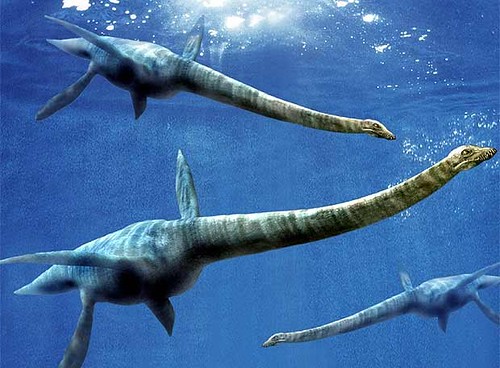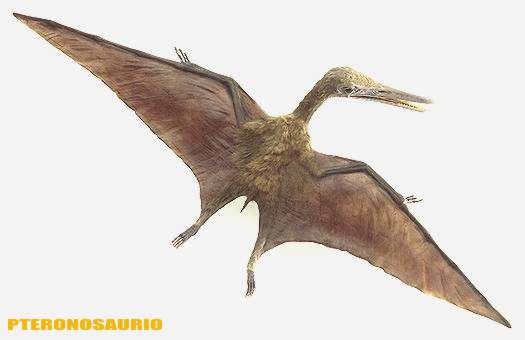dinosaurs shared the planet with many ciraturas other extinct today. While dinosaurs roamed the land, huge marine reptiles swam in the oceans.
 planned Flying reptiles in the sky hunting insects, fish and sometimes larger prey. Along with these animals, the first (and small) antepasadaos of birds and mammals struggling to survive while trying not to become food for larger animals.
planned Flying reptiles in the sky hunting insects, fish and sometimes larger prey. Along with these animals, the first (and small) antepasadaos of birds and mammals struggling to survive while trying not to become food for larger animals. Many groups of animals that still live today first appeared in the Mesozoic era. Mammals such as Morganucodon , the size of a shrew, appeared during the late Triassic period. But for most of the Mesozoic mammals were small animals hidizos, the size of rats or rabbits. Animals only became dominant when the dinosaurs disappeared. During the Triassic period also developed frogs and crocodiles, as well as turtles and tortoises. Lizards and more primitive birds, as Archaeopteryx, first appeared in the Jurassic period, while snakes did so during the Cretaceous period.

sea reptiles of the Mesozoic seas in marine reptiles inhabited spectacular, such as ichthyosaurs, plesiosaurs, and mosasaurs Pliosaurs. Of these, the ichthyosaurs were best adapted to marine life. They looked very similar to the dolphins, elongated and pointed hocidos full of sharp teeth, fins and a powerful tail guidelines in the form of a crescent. Ichthyosaurs could not leave the sea to lay eggs, so that gave birth pups in the water. The plesiosaur had a long neck, short and stocky body and a small head with very sharp teeth and sharp. Modified legs were as large oars that could shake up and down to propel the water. Pliosaurs plesiosaurs were like, worse had the shorter neck and head much larger. One type of pliosaur, the Liopleurodon was the largest carnivore that ever existed. The head of this creature was more than 2m in length! The mosasaurs were giant lizards closely related to the current monitors. They all lived during the Late Cretaceous period. These marine reptiles fed on fish, squid and shellfish. Pliosaurs bigger too often eat other marine reptiles. With the exception of turtles, all marine reptiles became extinct at the end of the Cretaceous period.


The flying reptiles or pterosaurs, flying reptiles appeared at the beginning of the Triassic period and survived until the end of the Cretaceous period. Pterosaurs could have different sizes. Most were the size of a pigeon or a crow, but some were very small, like a sparrow. At the other end of the scale we find the animal largest flying that has never existed, a pterosaur called Quetzalcoatlus . The Quetzalcoatlus , the end of the Cretaceous period of North America, had a wingspan of about 12 m, ie, was larger than a plane. Pterosaur wings were formed by a long finger holding a sheet of skin is very thin but very sturdy. This plate was attached to each side of the body along the arm. Pterosaurs lived around rivers and lakes, also nesting on sea cliffs. Most pterosaurs ate insects, fish and other small animals.

